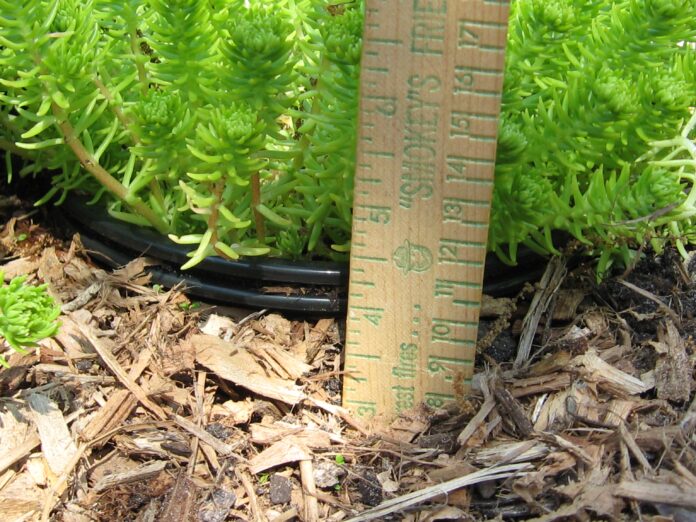Many of us, hopefully most, care if we save potable — i.e., drinking — water in the landscape. About 1,000 people move to Florida daily. This will create an increase in the overall water demand, and water is a nonrenewable resource. To make sure there is enough to go around, each of us needs to consider ways we can save potable water in our landscapes.
Here are some examples of Florida-Friendly Landscaping™ principles and related practices that conserve water. The options below can save water and money and cost you absolutely nothing, and they include shutting it off and a free irrigation evaluation.
Shut it off — “it” being your irrigation controller. Yes, there is an ‘off’ setting, which is a good option, especially now, during the rainy season. Do you walk or drive down your street, as rain is falling, and see your or your neighbors’ irrigation systems in operation and wonder why? We also wonder why. Please see the sections below: functioning rain shutoff device and free irrigation evaluation. Both paragraphs may be eye-opening.
Florida Statute 373.62 (2009) requires a functioning rain shutoff device where in-ground irrigation has been installed. The life expectancy of some of these devices is one to three years. Is yours working? If your irrigation system is running when it’s raining, chances are it is not.
We have staff that conduct irrigation evaluations. Contact Will Stone of UF/IFAS Extension Hillsborough County at 813-744-5519. He can provide more information on how to determine if your rain shutoff device is working correctly or if you need to look at alternatives. Stone schedules free irrigation evaluations on-site or over the phone for high-water users — 20,000 gallons per month or more. Check your water bill, which shows the number of gallons of water you are using. Please refer to the University of Florida publication “Residential Irrigation System Rainfall Shutoff Devices, or Rain Sensors” by Michael D. Dukes and Dorota Z. Haman at http://edis.ifas.ufl.edu/ae221.
Purchase drought-tolerant plants, which require significantly less or no water after establishment. Plants need water to become established, meaning root and shoot growth. How do you know if your plants are drought-tolerant? Extension offices have copies of “The Florida-Friendly Landscaping™ Guide to Plant Selection and Landscape Design.” This guide provides information on plant materials for Florida, and the key is useful to identify plants with high, medium and low or no drought tolerance.
Hydrozone your plants. This means grouping your plants according to their watering needs. Again, the “Plant Selection Guide” will be beneficial because it shows the soil moisture needed by the plants in the guide, from well-drained to wet and four categories in between. An example of why we should hydrozone our plants would be planting an herb garden and cactus together. If you water the herbs to meet their needs, the cactus will be overwatered and die.
Plant ground covers instead of turfgrass where turf is not purposeful. Turfgrass purposes can include play areas for children, a pet area for dogs, putting green, etc. Ground covers generally require less water, fertilizer and pesticides than turfgrass. The guide referred to above provides information on several ground covers that will work in our area. Just note the site conditions (sun, shade, soil texture, soil pH and soil moisture) in your landscape and select accordingly. If you live in a deed restricted community, check your deed restrictions and meet with your landscape review or architectural control committees as required before making changes.
Mulch landscape beds (2-3 inches deep after settling). Mulch is beneficial because it retains moisture in the soil, moderates soil temperature, reduces runoff and erosion, improves soil structure, suppresses weeds, enhances the beauty of the landscape, provides increased area for root growth and protects plants from lawn mowers and weed eaters. Organic mulches recommended include eucalyptus, melaleuca (punk tree), pine bark, pine straw and oak leaves.
Microirrigation is great for landscape beds. We also offer patio/container and vegetable microirrigation workshops. Compared to traditional in-ground irrigation systems, microirrigation provides gallons of water per hour instead of gallons per minute. This irrigation method not only conserves water, but it is also less restricted by water restrictions.
Apply 1/2-3/4 of an inch of water (irrigation or rainfall), which is all plants need per watering event. How do you know how much water you received from rainfall? Use a rain gauge to determine whether this amount has been reached and empty the rain gauge after viewing it. You can also do a ‘catch can test’ to determine the amount of water your in-ground irrigation system is providing by individual zone. For more information on the catch can test, please see the University of Florida publication “Frequency of Residential Irrigation Maintenance Problems” at https://edis.ifas.ufl.edu/publication/ae472.
Harvest rainwater for ornamental plants, not edibles, if captured from your roof. We offer this class monthly from February through November. Please visit our calendar of events at https://sfyl.ifas.ufl.edu/events/?location=hillsborough.
Consider creating a rain garden in a low area of your landscape. This will decrease some of the stormwater runoff from your yard. Rain gardens are a beautiful landscape addition. Plant selections should include those that like wet feet and are drought-tolerant for times when we don’t receive much rain. Consider using swamp hibiscus, swamp sunflower, wire grass and muhly grass. Before you purchase plants for your rain garden, determine the existing site conditions. Rain gardens installed in sandy soils only hold water for a few hours.
Bottom line: all of us have a stake in and impact the future. Conserving water in our landscapes involves easy options, as shown above. For assistance with horticultural questions in Hillsborough County, call 813-744-5519.
Contact: labarber@ufl.edu.



